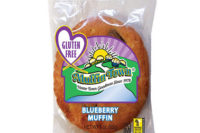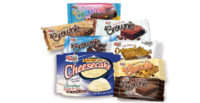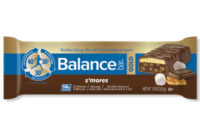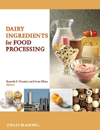The Healthy Have It
















Healthful eating isn’t a fad. It has become a way of life for an increasing number of Americans. Not only is there now more blending of the consumer base and products, but the growth of organic and “natural” foods is mimicking that of conventional products. Food manufacturers have jumped onto the healthful products train with a host of whole-grain bakery and snack product lines, organic offerings and products with “natural” ingredient profiles.
The numbers say it all. U.S. sales of organic food and beverages have grown from $1 billion in 1990 to $26.7 billion in 2010, according to the Organic Trade Association’s 2011 Organic Industry Survey. Sales in 2010 represented 7.7% growth over 2009 sales.
The reach extends across all food channels, with mass-market retailers selling 54% of organic food, according to the report. As more attention is placed on the correlation between chemicals in
food and diseases, the numbers for the $62-billion “natural” products industry are just as impressive. Sales of natural products across all retail and direct-to-consumer channels has almost doubled in size, from $32 billion in 2001, according to Natural Foods Merchandiser.
Whole-grain gains
Although the definition of whole-grain foods has become a point of confusion for many segments of the supply chain, due to recommendations by the Food and Drug Administration (FDA), more Americans are consuming products containing whole grains.
In fact, NPD Group, a Chicago-based research firm, reported a 20% increase in whole-grain consumption from 2005 to 2008, the most recent data available.
“There has been a 60-90% increase in new whole-grain product introductions during this period, compared with a 3% increase in 2011,” says Judi Adams, M.S., R.D., president of the Wheat Foods Council. “Whole grains are everywhere.”
The consumption evolution
Much of the increase in consumption and demographic expansion can be attributed to new technologies that have improved the taste, texture, overall quality and shelf life of whole-grain, “natural” and organic products.
Whole-grain products, in particular, are much improved compared with those produced years ago, Adams says. “The whole-grain white flour products now on the market have brought in many new users, and sales have been pretty phenomenal.”
According to The Organic Center, a Boulder, Colo.-based research firm that conducts evidence-based science on the health and environmental benefits of organic food and farming, organic bread on average contains more whole-food ingredients, or 49%, than conventional bread, which typically has 12%.
Conventional bread typically is higher in preservatives and additives. On average, 28% of conventional bread ingredients are preservatives and/or additives, the firm’s research indicates. On average, 63% of organic bread ingredients are significant sources of important nutrients, while 27% percent of conventional bread ingredients are nutritionally beneficial. When excluding the vitamins that are added to enriched flour, only 19% of conventional bread ingredients are nutritionally beneficial, according to the report.
To help promote whole grains in schools, seven trade associations, in conjunction with Kelloggs and General Mills, have created The Grain Chain. The fall promotion is intended to encourage children to make half of the grains they consume whole grains.
This is in preparation for the U.S. Department of Agriculture’s (USDA) recommendation that all grains in schools be whole grains by 2014. “The FDA Dietary Guidelines don’t specify that all grains should be whole grains, so schools may be the only place many children get these products,” Adams says.
Looking at the bread shelves, it’s evident that the broader conventional bread market has shifted from white to whole grain. “From a category standpoint, whole grain continues to grow in the double-digit range, despite the fact that the bread category, as a whole, averages 1-2% growth a year,” says Doug Radi, senior vice president of marketing and conventional sales for Rudi’s Organic Bakery, Boulder, Colo.
Looking back, the growth in natural and organic products really took off in 2007, but with the recession, the growth became flat for many manufacturers between 2008 and 2009. However, since late last year, natural and organic food sales have begun to creep back up, say manufacturers.
“For certain segments of consumers, natural and organic foods are a ‘want to have’ and not a ‘must have,’” says Doon Wintz, president of Chester, N.J.-based Wholly Wholesome. “The growth in these segments is based on consumers’ disposable income and follows the economic health of the nation. We’re seeing growth, but it’s slow.”
Since the creation of Mom Made Foods, Alexandria, Va., six years ago, many organic foods have become more mainstream. “This is because consumers appreciate what the organic label stands for,” says Heather Stouffer, founder and CEO of the company. “We’re finding that the mainstream consumer is looking for organic more than ever five years ago.”
Consumers today are more likely to read labels and choose products with fewer ingredients that are unrecognizable. There is a definite tie between organic labels and clean ingredients. “This is becoming clearer to the average consumer,” Stouffer says.
Complementary crossovers
There can be much crossover, particularly between the “natural” and organic product segments. Kinnikinnick Foods’ products aren’t organic, but the company’s gluten-free lines have been slotted into the natural category.
“This segment has continued to grow on a regular basis, but has slowed in the last 18 months, due to the economy and increased competition in the marketplace,” says Jerry Bigam, the Alberta, Canada, company’s president and CEO. “Although the ‘natural’ market is more split up, the sector is continuing to grow as much as or better than other sectors of the food industry.”
Cornfield’s, a private-label manufacturer in Waukegan, Ill., provides both “natural” and mainstream products to national retailers. The certified-organic company assists its customers in establishing organic brands.
“The ‘natural’ category has crossed over into mainstream traditional retailers,” says Claire Cretors, Cornfield’s president. “We’re also seeing great excitement around whole grains.”
Nearly two years ago, Cornfield’s launched its G. Cretors Popcorn line made of whole grain. This product is now available in a Chicago blend that combines cheese and caramel popcorn in one bag. Rather than the conventional corn syrup, the company’s caramel corn incorporates brown rice syrup, a natural sweetener.
Earlier this year, the company also debuted its Hi I’m Skinny brand, a snack stick product made of whole grains.
“We feel responsible for delivering something that provides more than empty calories,” says Cretors. “There was a period of time two years ago when the economy was struggling and innovation was stagnated. Now we’re seeing more interesting snacks using different processes. As a result, manufacturers are delivering something different to consumers than they are used to.”
Consumers are also more educated about organic, “natural” and whole-grain products and what they encompass. New product innovation has transformed the buyer profile—formerly high-income and primarily women—to include more men and younger consumers that may have less disposable income.
“These products are hitting the mainstream, not just certain demographics,” says Eric Brenner, chief culinary officer at Bold Organics in New York, N.Y. “There has been a huge shift in the way people think about food. They now understand that things that sit on a shelf for five years are not the best to eat.”
There are hard realities involved in creating some types of products. For example, it might be more difficult and time-consuming to grow organic and whole-grain ingredients. “I don’t think the whole market will get there, but limitations are in the perception,” Brenner says. “The products can be expensive to produce, but we’ve found a way to offer products at a price-per-ounce that offers value, which is key.”
The search for cleaner labels
As the market and demographic has expanded, new product launches have kept pace. Wholly Wholesome has seen increasing interest in its whole-wheat pie shells. “We did experience growth this year, but not the kind we enjoyed in the mid-2000s,” Wintz admits. “In 2012, we will see whole wheat overtake white wheat in terms of frozen pie shells.”
The company also is pursuing ancient grains, such as quinoa, amaranth, spelt and Kamut, which is a patented variety of wheat. “We don’t know if these are fads or trends, but there’s a lot of excitement about them,” Wintz says.
Also becoming more popular is incorporating nutraceuticals, like probiotics, into baked goods. This practice has given the yogurt category a big boost. By encapsulating these ingredients into organic and “natural” baked goods, as well as snack foods, manufacturers hope to grow these categories.
And some manufacturers contend that the children’s market has yet to be fully tapped in terms of natural, organic and whole grain products. Mom Made Food was initially launched at a local farmers market outside of Washington, D.C. and, when it tested well, the company took its products national.
The company’s frozen organic kids’ products are geared toward those ages two to 10, but have appeal and interest from people of all ages. Products include macaroni-and-cheese meals that include sweet potato butternut squash puree and a turkey meatball bite entrée that is low in sodium and antibiotic-free.
“We’ve taken kid- and family-friendly recipes and made them healthier,” Stouffer says. “Consumers are seeking the buzz words, like gluten-free, antibiotic-free, hormone-free and low sodium. Everyone is looking for cleaner products in general.”
In recent months, Kinnikinnick Foods introduced four new products, including soft white bread, soft multigrain bread and soft hamburger and hot dog buns. “One of the most important aspects is to get our bread down to the texture that the conventional industry offers, and that’s what these breads do,” Bigam says.
The new bread lines include an ingredient structure that took a year to develop. The focus was on improving the texture as well as incorporating more nutritious ingredients, such as rice, tapioca starch and potato starch, Bigam adds. The breads have 5 g. of fiber, use enriched flour and have no artificial preservatives or ingredients. Kinnikinnick also has placed a great deal of effort on new packaging imagery in the last year to identify the company’s products as free of gluten and allergens.
This year, Rudi’s Organic Bakery launched into the flats segment, introducing two sandwich Flatz brands and two bagel Flatz varieties. The products are positioned for consumers seeking lower calorie, portion-control breads.
As a certified-organic products supplier, Bold Organics also utilizes organic grains, vegetables and non-dairy cheese. “We will continue to see an increase in healthier eating,” Brenner says. “Once the number of people hits a critical mass, stores will start opening up to even more of these products.”
As the demand for “natural,” organic and whole grains continues to grow, prices may become more in line with conventional products and availability will continue to increase. “I’m excited about the future and potential of these markets,” Radi says.
Looking for a reprint of this article?
From high-res PDFs to custom plaques, order your copy today!

















